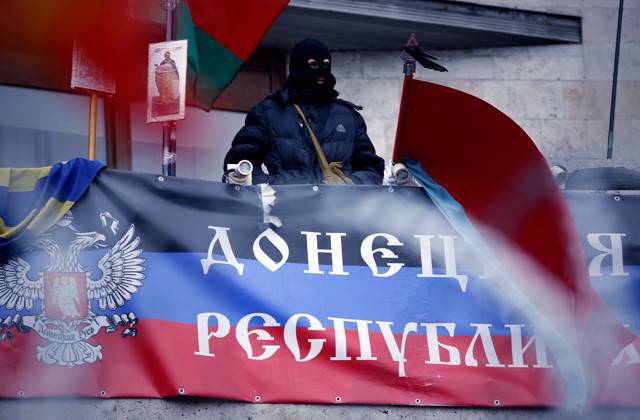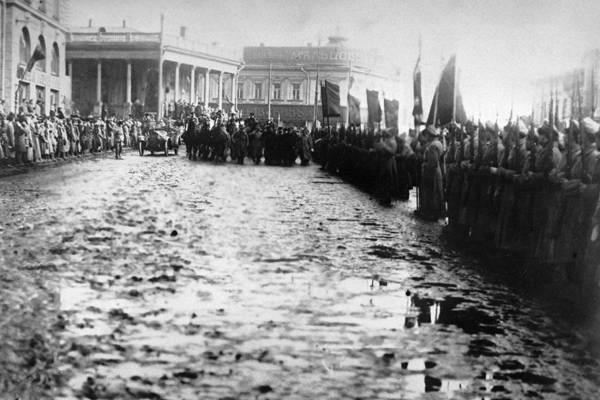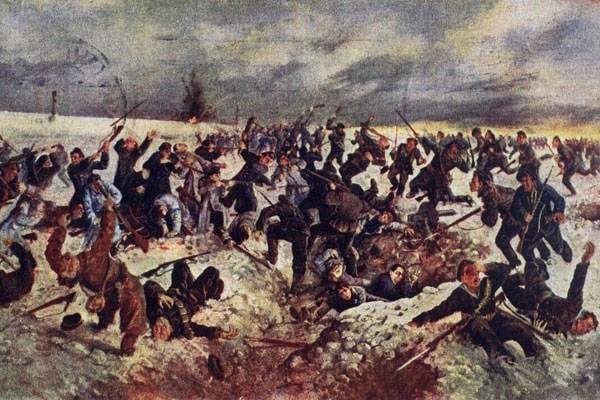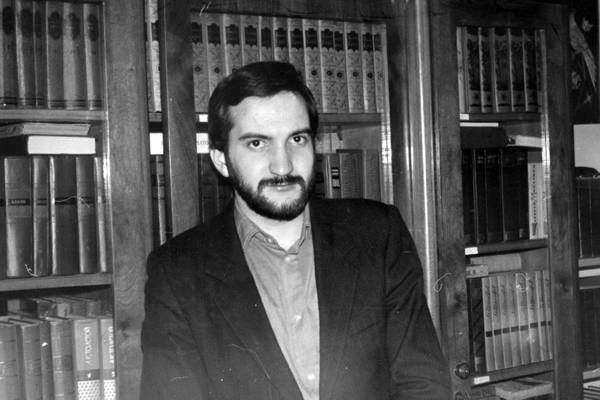Donetsk Republic: Myths and Reality

From the revolution of 1905 to the collapse of the USSR: why an independent republic in the Donbass did not suit either the Bolsheviks or Ukrainian nationalists and was considered historical incident
"Economic indivisibility" of Donbass
For the first time, the idea of administrative unification of the territories around the Donetsk basin began in the late 19th century. Donbass was then one of the leading industrial centers of the Russian Empire. Its coal mines, steel plants and machine-building enterprises accounted for almost a third of the Russian economy of those years.
But this region shared the administrative boundaries of the two provinces, Ekaterinoslav and Kharkov, and the Region of the Don Army, where there were specific rules of commerce.
It is no coincidence that the idea of the existence of a separate region with its own special interests and connections was first expressed by the Council of Congresses of Miners of the South of Russia - the union of the leading capitalists of Donbass. Among its creators were engineer-geologist Petr Gorlov, the founder of Gorlovka, one of the economic centers of the modern Donetsk region, and the Kharkov banker Alexey Alchevsky, the founder of Alchevsk, now a large industrial center of the Luhansk region.
It was the Council of Congresses of Miners who first formulated the idea of the “economic indivisibility” of the Donets Basin. Historians believe that in Czarist Russia, this Council was the first and most representative organization of large capital of a regional nature.
From economic indivisibility to political subjectivity one step. And he, too, was made by the Council, but not by the miners-capitalists, but by the workers' deputies. The revolutionary tradition of Donbass is not inferior to industrial, in December 1905, Moscow and Donetsk Gorlovka became the centers of armed resistance.
16 December 1905, police and troops opened fire on unarmed strikers at the machine-building plant in Gorlovka, dozens of people were killed and injured. The next day, workers from nearby factories and mines, about four thousand people, almost without weapons drove the troops and the police out of the city. When the dragoon regiment approached Gorlovka, the rebels refused to lay down their arms and fought with the troops for six hours. The score of those killed was hundreds. It is no accident that it is this uprising that General Denikin will mention in “Outlines of the Russian Troubles”, considering the Donetsk insurgents as the forerunner of the Makhnovist movement.
After February 1917, the unitary Russian Empire began to actively share. And if in Kiev and on the right bank of the Dnieper, the ideas of the Ukrainian “separatist” prevailed, then in the Donbass, with its initially mixed population, they were skeptical or hostile. In April, 1917, the first congress of the Soviets of the Donetsk and Krivoy Rog Basins was held. Deputies gathered in Kharkov, it was there that for decades the Council of Congresses of Miners of the South of Russia was located, and the city was long perceived as the informal capital of the region.
The congress deputies selected from among workers hundreds of industrial enterprises and mines united by a common economy and technological processes, hence the proximity of political positions.
The congress united about a hundred local councils from the miner's Makeyevka in the former Oblast of the Don Cossack Army to Krivoy Rog, the center of iron ore mining on the right bank of the Dnieper in the western part of the Yekaterinoslav province. The congress decided on the formation of the Donetsk-Krivoy Rog region. Kharkov became the capital of the new region, while the new region was not separated from Russia, but wanted to directly submit to Petrograd.
Kharkov against Kiev
The congress of councils opposed itself to the Central Rada, which met in Kiev, which, as the revolutionary chaos increased, claimed to be increasingly independent of the Ukrainian territories. By August 1917, a dispute arose between the Provisional Government in Petrograd and the Central Rada in Kiev about the borders and what should be considered Ukraine.
It is indicative that the Donetsk oligarchs of a century ago frankly did not want to go to a separate Ukraine. Nikolay von Ditmar, one of the leaders of the Council of Congresses of Miners of the South of Russia, the owner of Kharkov factories producing mining equipment for enterprises of Donbass and Krivoy Rog, 1 August 1917, at a meeting of the Provisional Government in Petrograd, spoke about the relations between Donbass and Kiev: industrial relation, and in geographical and household seems completely different from Kiev. This whole area has its completely independent primary importance for Russia, lives an independent life, and the administrative subordination of the Kharkiv district to the Kiev district is absolutely not caused by anything. Such artificial submission will only complicate and complicate the whole life of the district, especially since this submission is dictated by questions of expediency and government requirements, but exclusively by the national claims of the leaders of the Ukrainian movement. ”

The Provisional Government took into account the wishes of the Donetsk "oligarchs" and 4 of August 1917 of the year decided that only five provinces of the former empire - Kiev, Volyn, Podolsk, Poltava and Chernigov - were the territory of Ukraine.
The Kiev Central Council in August 1917 claimed to be much larger territories and immediately declared "the imperialist tendencies of the Russian bourgeoisie in relation to Ukraine." However, the opponents of the Rada were not only the Russian bourgeoisie, but also the Bolsheviks of Donbass and Kharkov. Already in September 1917, the leader of the Bolsheviks of Kharkov, Fyodor Sergeyev, who remained in history as "Comrade Artem", expressed the idea of "decreing (that is, proclaiming) the republic of the Kharkov province, the organization of which the entire Donetsk basin will be involved."
Immediately after the overthrow of the Provisional Government in Petrograd, the Central Rada in Kiev proclaimed the Ukrainian People’s Republic (UNR), which included Kharkov and Donbass without prior arrangement. In response, the Soviets of the existing 16 of Donetsk-Krivoy Rog region in April 1917 made an official decision: “Expand a wide campaign to leave the entire Donetsk-Krivoy Rog basin with Kharkov as part of the Russian Republic and to attribute this territory to a special, unified administrative-self-governed region ".
In February, the Fourth Congress of Soviets of Donetsk-Krivoy Rog Oblast gathered in Kharkiv on November 9, 2011. One of the main issues on the agenda of the congress was formulated very simply: "On the allocation of the Donets Basin".
12 February 1918, at the Metropol Hotel in Kharkiv, after the heated debates of the 50 congress delegates from 74, supported the decision to proclaim the Donetsk Republic. A government was formed, a council of people's commissars of the new republic, which included representatives of the Bolsheviks, Left Social Revolutionaries and Mensheviks. The head of the government of the new-born republic, the leader of the local Bolsheviks, “Comrade Artyom,” the next day sent a telegram to Petrograd Lenin and Sverdlov: “The regional congress of Soviets adopted a resolution on the establishment of the Council of People’s Commissars of the Donetsk-Krivoy Rog Basin as part of the All-Russian Federation of Soviets.”
Donetsk v Ukraine
In fact, the Donetsk Republic was created as a regional denial of the “Petliura” UNR. At the same time, this was a statement by Kharkov and Donetsk Bolsheviks against their Ukrainian party colleagues, who insisted on the incorporation of Donbass into the composition of the non-existent Soviet Ukraine.
In the documents of that time, the newborn republic was called differently: Donetsk Republic, Donetsk Republic of Soviets, the Republic of Donetsk and Krivoy Rog Basins, the Federal Republic of the Donetsk Basin. The history of this state formation of the revolutionary era entered as the Donetsk-Krivoy Rog Soviet Republic.
By the standards of the revolutionary time, the republic formed by the deputies from the regions and enterprises was quite legitimate. For example, the Kiev Central Rada was formed without prior arrangement by the leaders of Ukrainian nationalists without elections.
Three days before the proclamation of the Donetsk Republic, the Rada, already fleeing from Kiev after the Reds attacked, signed an agreement with Germany and Austria-Hungary in Brest, in accordance with which German troops were introduced into the territory of Ukraine. The problem was that at that time no one knew where the Ukrainian territory in the east of the Dnieper ends. In Kharkov, consulates of a number of European countries — France, Britain, Belgium, Sweden — were located, and the leaders of the Donetsk Republic through them circulated their appeal that Donbass and Kharkov were not part of Ukraine.
“As for the borders of our republic,” the document stated, “they should be known to the Kiev government. Just a few months ago, the Kiev Rada, in an agreement with Prince Lvov and Tereshchenko, established the eastern borders of Ukraine just along the line that was and is the western borders of our Republic. The western borders of the Kharkov and Yekaterinoslav provinces, including the railway part of the Krivorozhie Kherson province and the counties of the Tauride province to the isthmus have always been and are now the western borders of our republic. ”

But the force was on the side of the divisions of the German Kaiser and the Austrian emperor, in whose headquarters they determined the boundaries of "independent Ukraine" without prior arrangement. Germany in the context of the ongoing world war needed bread Black Sea and the resources of the Donbass, so in Berlin decided to consider them Ukraine.
Donetsk Republic tried to resist. 16 March 1918 was issued a "Decree of hostilities", which announced the "entry of the republic into the South Russian military alliance in order to jointly combat the German occupation." At the end of the month, the Red Army of Donbass was formed, headed by staff captain (captain) Anatoly Hecker, who fought on the Romanian front before the imperial army collapsed. But eight thousand Donetsk Red Guards could not stop the advance of the German and Austrian divisions.
7 April 1918, the Germans occupied Kharkov. Behind them, the Zaporozhye Corps of the Central Rada entered the capital of the Donetsk Republic. The government of the Donetsk Republic retreated to Lugansk, which was declared the new capital of an independent Donbass. 28 April, the Germans occupied Lugansk. The leaders of the Donetsk Republic and the detachments of the Donetsk Red Army retreated beyond the Don, and then, through the territories controlled by pro-German cossacks ataman Kaledin, broke through to Tsaritsyn.
In August 1918, Germany and Soviet Russia signed an additional treaty to the Brest peace agreements. Moscow agreed to pay the Germans a large contribution of gold, but Germany, in turn, pledged that "she would neither call for nor support the formation of independent state organisms" in the territory of the former Russian Empire she occupied. During these negotiations, representatives of Soviet Russia declared that they did not recognize either the Crimea or the Donbass as part of independent Ukraine. The Donbass in the documents of this agreement was called “temporarily occupied territory”.
In November 1918, the revolution took place in Germany and the German occupation regime collapsed. In December, the Reds took 1918 to Kharkov, and the Council of People's Commissars of the Donetsk Republic returned to the city.
But at that moment the Bolsheviks had already claimed all the territories of the former Russian Empire. Therefore, the party leaders led by Lenin chose to create a large Ukraine on both banks of the Dnieper. 17 February 1919 was resolved by the resolution of the Council of Defense of the RSFSR The Donetsk-Krivoi Rog Republic was liquidated. And on March 10 of the same year, the Ukrainian Socialist Soviet Republic was formed at the Congress of Soviets in Kharkov. In the then adopted Constitution of the Ukrainian SSR, Soviet Ukraine was proclaimed part of the future planetary United International Socialist Soviet Republic.
But the world revolution did not happen, Soviet Ukraine became part of the USSR. At the same time, Kharkov was its capital until 1934. But the city of Taganrog inherited from Ukraine by the inheritance from the Donetsk Republic was transferred to the RSFSR as early as 1924.
"Donetsk Republic" against the "Galician Republic"
The idea of the Donetsk Republic was forgotten for many decades. In Soviet times, the history of an independent state entity in the southeast of the Ukrainian SSR was not popular, as it could cause undesirable for the official ideology questions about the randomness of the appearance of certain borders within the Soviet Union. Donetsk republic in Soviet historiography has always been viewed at a glance, as a kind of curiosity of the times of revolution and civil war.
It is natural that the new revival of the idea of the Donetsk Republic fell on the period of the collapse of the USSR. At sunset "perestroika" in the Ukrainian SSR, the ideas of various republics were popular. In the case of the signing of a new union treaty, the Western Ukraine regions threatened not to sign it and create their own Galician republic.
For the first time, the idea of the new Donetsk Republic sounded in the summer of 1991, as a counterbalance to the "independent" ideas of the West. 20 July 1991 of the year Komsomolets Donbass newspaper published an article “Donetsk Autonomous Republic - maybe this is the way out?” The publication proposed to hold a regional referendum and answer the questions: whether to remain the Donetsk region as part of Ukraine, form autonomy within it, enter whether it is part of Russia as a region or autonomy, or “to improve its status and become a Donetsk republic”.
Some Donetsk deputies of the Supreme Soviet of the USSR then declared the need to "recapture" the separation of a number of south-eastern regions of Ukraine into a "territorial autonomous entity". In parallel, at different levels, the ideas of Donetsk federal land within Ukraine were put forward more than once.
The August events in Moscow and the actual paralysis of the Allied leadership aggravated the situation in Ukraine. 28 August 1991 was quite popular during the years of perestroika in the Donetsk region. The Donbass International Movement issued a statement that southeastern Ukraine "could become the arena of serious clashes of various political forces," and therefore a referendum on autonomy within the Ukrainian SSR should be held here by the end of the year. The document emphasized that the region "does not think of itself in isolation from either Ukraine or Russia."
The movement of Donbass played a decisive role in the revival of the legend and the very idea of the Donetsk Republic. It appeared at the end of 1989 of the year, like all other similar “International fronts” from Transdniestria to the Baltic states, becoming a response to the strengthening of nationalist forces and ideas in the crumbling USSR. Then the leader of the Donetsk Interdvizheniya became then 28-year-old school teacher of English one of the rural schools of the Donetsk region Dmitry Kornilov. His younger brother, Vladimir Kornilov, two years ago published the book Donetsk-Krivoy Rog Republic: The Shot Dream, the most complete documentary study of the history of the Donetsk Republic during the Civil War.

It was activists of the Interdvizheniye Donbass, immediately accused by Ukrainian politicians of separatism, who invented the flag of the non-existent republic at the beginning of 90-s. The red-blue-black tricolor, as envisioned by its creators, should reflect the spirit of the region. The black bar symbolizes the “fertile land of the South of Little Russia and the Donbass coal”, the blue color symbolizes the waters of the Azov and Black Seas, and the red color - the revolutionary traditions and the blood shed in the struggle for freedom. At the same time, the flag of the historic Donetsk Soviet Republic was exactly red.
In the autumn of 1991, in Donetsk, members of the Interdvizheniya Donbass began collecting signatures in support of the demands for autonomy in the region. At the end of October in Donetsk, a meeting of deputies of councils of all levels of the south and east of Ukraine adopted an appeal to the authorities of the Ukrainian SSR, which required "to make a provision on the federal-land structure in the concept and the draft Constitution of Ukraine."
At the very end of 1991, in Donbas, there were calls for the creation of a separate state and its own armed forces. So in Lugansk, the leaders of the public movement “Democratic Donbass” on the pages of the local newspaper “Molodogvardeets” called on local Soviets of Deputies to hold the Donetsk Assembly, where to decide on the creation of a “Republic of Little Russia”. It was supposed to unite at least the Donetsk and Lugansk regions and create its own law enforcement agencies "to protect the borders."
The hypothetical Little Russia was supposed to secede from Ukraine “conditionally”: in the event of the Ukrainian SSR secession from the USSR, become an independent state, and if the USSR does not collapse, the future republic will remain autonomy within Ukraine. As the Lugansk activists of the “Democratic Donbass” were called on, the autonomous Little Russia “will defend its interests in the Ukrainian parliament and not dance under the Kiev-Galician pipe”.
At that time, an active and nervous discussion took place around the ideas of the Donetsk Republic in the region on the pages of newspapers and leaflets, on rallies and other numerous political events at that time. A typical complaint to supporters of the Donbass idea from the nationalist movements of Ukraine was the accusation that “the separatists are striving to create a communist reserve” in the Donbas.
"They have never been and never will"
At the beginning of 90, the political confrontation around the idea of an independent Donbass remained at the level of the idea, not spilling out onto the streets en masse.
The “Declaration of the Rights of the Peoples of Ukraine” adopted by the Supreme Council in Kiev on November 1 of the year adopted by the Supreme Council in Kiev contributed to the removal of the growing conflict. The declaration proclaimed in every way the equality of all peoples and in particular emphasized that "the Ukrainian state guarantees to all peoples and national groups the right to freely use their native languages in all spheres of public life, including education."
First of all, this document of official Kiev was reassured by the Russian-speaking majority.
All the years of Ukraine’s independence, the memory of the existence of the Donetsk Republic in its history remained marginal and inconvenient. The official historical science of Ukraine, examining that period of history, focused on the study of various manifestations of the “separatist” movement from Petlyura and Vinnichenko to various atamans. It was impossible to completely ignore Soviet Ukraine; in the end, without it, the modern borders of the Ukrainian state would not have appeared. Here, only the vector changed, if, for example, in the Ukrainian SSR the participants were Bolshevik uprisings at the Kiev plant Arsenal, then in the pantheon of modern Ukraine they were replaced by the “Krut heroes” who fought near Kiev with the advancing Bolsheviks.
The memory of the Donetsk Republic, which was created in the peak of both Petliura and Bolshevik Ukraine, is particularly inconvenient. Here, the historiography of modern Ukraine coincides with the Soviet one - a state entity in the south-east of the country, occupying a third of the current Ukrainian state, is interpreted exclusively as a minor incident of a turbulent era. But at the same time, the almost equally transient "Ukrainian People's Republic" by Simon Petliura is regarded as the most important and key stage in Ukrainian history, with the same level of legitimacy (or illegitimacy).
It is no coincidence that when, in 2011, a correspondent for the Donetsk edition of Observer publicly asked a question about the Donetsk Republic to ex-President Viktor Yushchenko, he replied that it had never been - only the name. “I want to say one thing: the Odessa republics, the Donetsk republics - they have never been and never will be,” he concluded.
Information